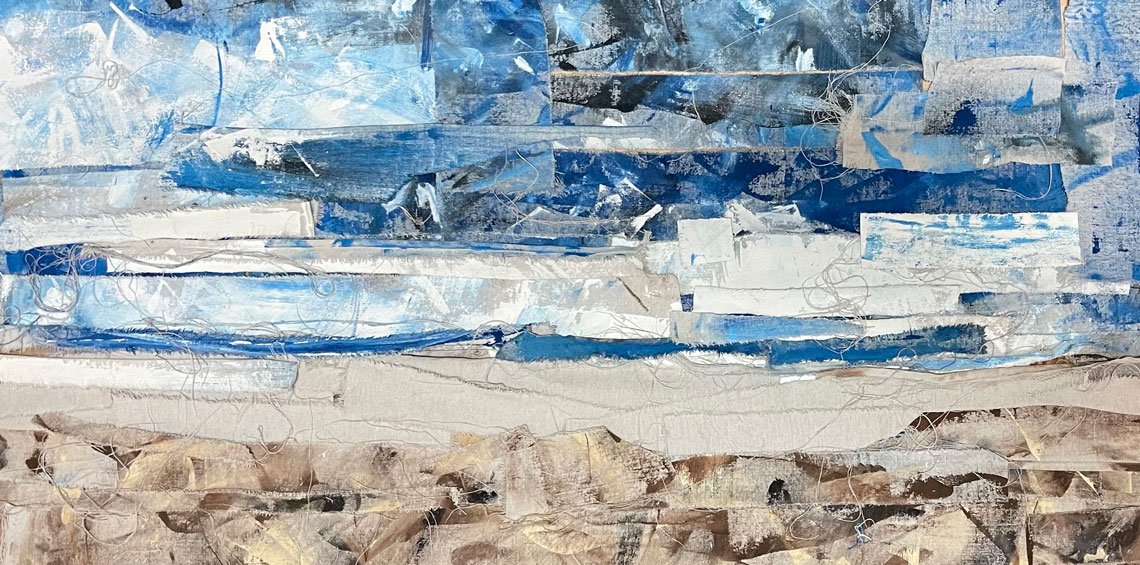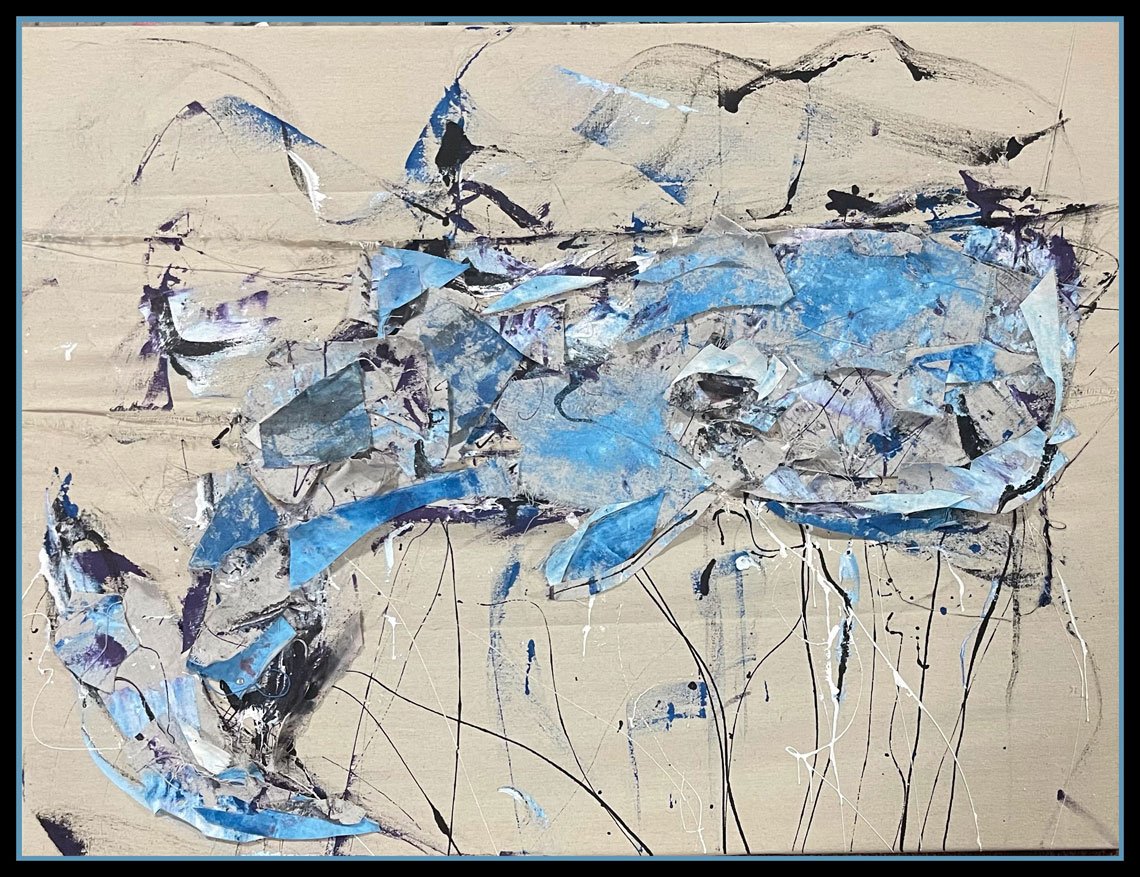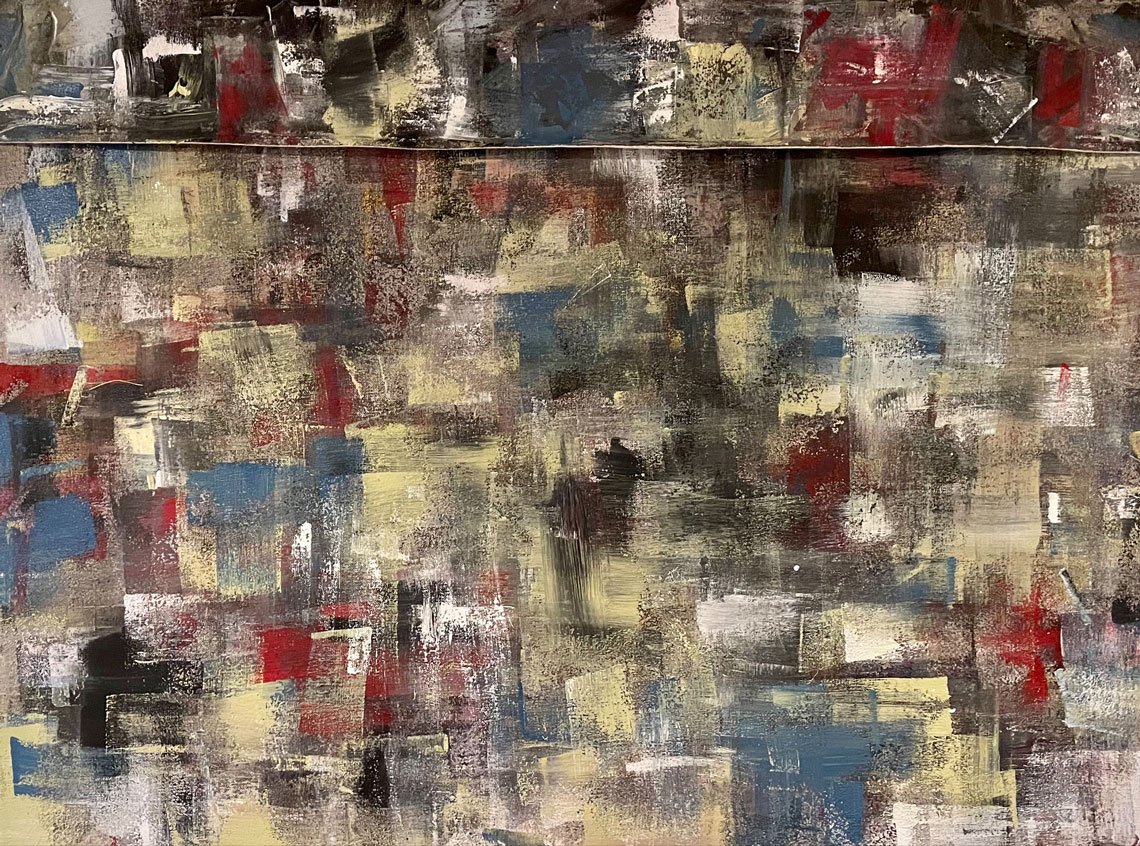Create Every Day, Every Way Long Island Artist and Creative Polymath Michael Ricigliano Showing at the Hamptons Fine Art Fair
 |
| Michael Ricigliano, Ocean Sand, 2021. Acrylic on strips of canvas, 24 x 48 in. |
Create Every Day, Every Way
Long Island Artist and Creative Polymath Michael Ricigliano Showing at the Hamptons Fine Art Fair
 | |
| Michael Ricigliano in his Long Island studio. |
Michael Ricigliano first made a name for himself as a screenwriter and filmmaker. He never formally studied art but during the pandemic, as film and television production ground to a halt, he began painting full time at his home in New York. A member of the Silvermine Guild of Artists, he has exhibited at the Steinberg Museum of Art, Heckscher Museum of Art, and Lilac Gallery in Manhattan, among others. He is exhibiting his latest works at the Hamptons Fine Art Fair opening July 13th.
What will you be showing at the Hamptons Fine Art Fair?
I am displaying with the Victory Art & Spirit Gallery at the Hamptons Fine Art Fair. I’ll most likely be showing a series of paintings called “Weathered Fences.” I like this series personally because of the muted colors and texture of the work. This is my most recent series of paintings and an important progression for me as an artist.
 |
| Michael Ricigliano, Weathered Fences Series, Grey and Blue, 2023. Acrylic on torn canvas, 36 x 40 in. |
 |
| Michael Ricigliano, Battle Scars, 2020. Acrylic on canvas, 36 x 48 in. |
Emblazoned on your website homepage is the phrase ‘create every day.’ Why did you choose that and what does it mean to you?
I am a firm believer that we each have our unique gifts, and that we should use those gifts as much as we can. The mantra, “create every day” is a reminder to not let our gifts go to waste.
 |
| Michael Ricigliano, Whale, 2023. Acrylic on canvas, 36 x 48 in. |
 | |
| Federico Castelluccio & Alan Sonfist attending the opening of WOVEN, an exhibition of pandemic-era works by Michael Ricigliano at the Steinberg Museum of Art. |
You have done so many creative things in your life, tell us about your background.
I grew up on Long Island where I received my undergraduate and law degrees at Hofstra University. While practicing law I had an idea for a film based on stories my father told me about growing up in Brooklyn and the Feast of Our Lady of Mount Carmel. Not having any experience in filmmaking, I decided to learn everything I could about screenwriting and producing films in general. I spent a year writing and building a team to make what ultimately became the 2016 release of the feature film “The Brooklyn Banker.” From there I wrote the off-Broadway play, “A Queen for a Day,” which had a successful run at the St. Clements Theatre. It was around this time that I started to explore visual art and was taken under the wing of artist Federico Castelluccio who had directed “The Brooklyn Banker.” Even as I continue to write for film and theatre I am immersed in creating art, which I find not only therapeutic but also a great way to transition from the specific focus required when writing a script.
Do you have formal training in any creative discipline?
I have no formal training nor did I study art, theatre or filmmaking in college or at the postgraduate level. I have had the benefit of mentors like Federico Castelluccio and the artist Alan Sonfist, they are each extremely knowledgeable and talented artists. They have been very kind in showing me different disciplines without trying to teach or direct my work in one way or another. They understand and appreciate that my talent lies in the ability to absorb and create without adhering to a specific style.
 |
| Michael Ricigliano, Lost at Night, 2020. Acrylic on wood, 24 x 24 in. |
How does the lack of formal training impact you creatively?
It’s freeing, knowing that without formal training, I don’t have to adhere to any rules. I’m certainly inspired by other artist’s works but I try not to emulate any specific genre or artist.
 |  | |
| Left: Michael Ricigliano, Red Stripe, 2021. Acrylic on canvas, 24 x 18 in. Right: Michael Ricigliano, Spiders Web, 2018. Acrylic on canvas, 40 x 30 in. | ||
How long have you been painting and what got you interested in art?
I started painting after we finished filming “The Brooklyn Banker” in 2015. Federico Castelluccio (our director) had seen some of my charcoal sketches and thought that I might be interested in expanding my interest in art, more specifically abstract art. He invited me to a “pop-up” gallery in Brooklyn showing local artists and their work. I was captivated by the scope of what different people were drawn to with abstract expressionism. I felt I could find a voice creating this type of art, and that moved me on that journey.
Did the pandemic impact your decision to work more on art instead of writing?
It did to a degree since the theaters and film sets were closed down, and even when they began to come back, the COVID protocols made it economically impractical to make an independent film or an off-Broadway play. Virtual galleries were becoming more popular because you could at least show your work to the public. I did however have the inspiration to write a play about a retired judge living in the city during the pandemic. It’s called “The Court of Oyer and Terminer” and we were able to have several readings via Skype.
 |
| Michael Ricigliano, Untitled, 2019. Acrylic on canvas, 24 x 36 in. |
How is making art different from writing for screen and stage?
The main difference for me is the fact that each piece of art, even in a series, is unique. It has a beginning and an end in a much shorter time frame than the time (months) that it will take me to write a single screenplay. Theatrical plays take even longer since I may have thirty drafts that are honed after half a dozen readings. I also enjoy feeling the texture of the canvas and paint as I create each piece of art. It’s a completely different process than writing which is much more cerebral.
What do you paint and what is your core inspiration?
As it relates to charcoal sketching, I tend to focus on the human reaction to adversity or anguish. Whether it’s a boxer in the later rounds of a fight, or religious figures contemplating their faith, I find those expressions to be more interesting to draw.
In painting, each series will focus on its own core inspiration: the Long Island landscape, as well as animals like the whale, bull, horse, peacock, etc. Sometimes the inspiration is more ambiguous like the pandemic and the isolation we felt living in boxes, isolated from human interaction.
 |
| Michael Ricigliano, Summer Box, 2020. Acrylic on canvas, 36 x 48 in. |
Do you paint every day and where do you work?
I will either paint or write every day. I normally focus on one discipline or the other for months at a time. I enjoy the variety of writing for an extended period about one subject and then working on multiple art pieces over the same period of time. I have a studio in my home that has expanded to several rooms for different kinds of work.
What materials do you use and why?
A few years ago, I began to look at my previous works and decided to try to create a new art piece using the original painted canvases. I did this by tearing the work into strips. I liked the rough and chaotic look of the pieces as I tried to weave them back together. From there, I began purposely creating artwork that could be ripped and torn into shreds and then woven back together to create a cohesive and interesting piece. I began using non-traditional instruments to paint with. I’ve become partial to using 8 or 10oz. canvas drop cloth that you find in any Home Depot. It takes the paint and dries quickly. It also tears unevenly and frays which is a nice touch when I’m rearranging the pieces back together. When spreading out the paint on the canvas I use a straight-edged piece of wood, metal, or plastic that will blend the paint to allow continuity with the piece. If I need to add more finite lines in the work I’ll use baker's string to slide across the surface.
 |
| Michael Ricigliano, Suntree, 2016. Acrylic on canvas, 36 x 36 in. |
Do you work in series or on individual pieces?
I do work in a series when I enter a new phase in my development or if I’m experimenting with a new medium. I try to be consistent with a color scheme if I’m happy with how it’s coming along.
Does living and working on Long Island influence your paintings?
I’ve definitely looked to my surroundings for inspiration, such as the Long Island Sound — its natural beauty, even the animal life that we find in New York. I’ve done several pieces directly inspired by the landscape here like the Great South Bay, horses running off of Chicken Valley Road in Brookville, a sperm whale, and even a peacock that lives on the grounds of the Westbury Manor Catering Hall.
 | |
| Michael Ricigliano, Elephant, 2022. Acrylic on canvas, 40 x 30 in. |
Which artists working today do you admire and why?
I admire all artists that are willing to put their work out to the public, especially younger artists. Just looking on Instagram I can see such immense talent and dedication to the craft that I feel a kinship to the art community. But I specifically like and admire Alan Sonfist who has become a mentor and friend. His experience and accomplishments as a pioneer of the land art movement I find daunting. To be so respected that your work is studied at colleges and universities throughout the world and is exhibited in museums is, I think for any artist, very rewarding.
Are there things you can do with art that can't be expressed in other creative media?
The impact of art is immediate. You see it, take it in, and process it. Film, television, and theater I think are interpreted over time. My art, or any artist’s work for that matter, can reach so many different people, from different backgrounds, who speak different languages, with only its placement on a wall.
What value does having art on the walls of a home bring?
The value to me is that my art can mean something completely different to every person that walks in that room. It can elicit happiness, wonder, even anger or distaste. It can even mean absolutely nothing at first glance, but then the viewer may see something that the artist never even meant to express. But no matter what the reaction, the artist still took the time and energy to create something, and someone thought enough of that creation to place it in their home for others to see.




























